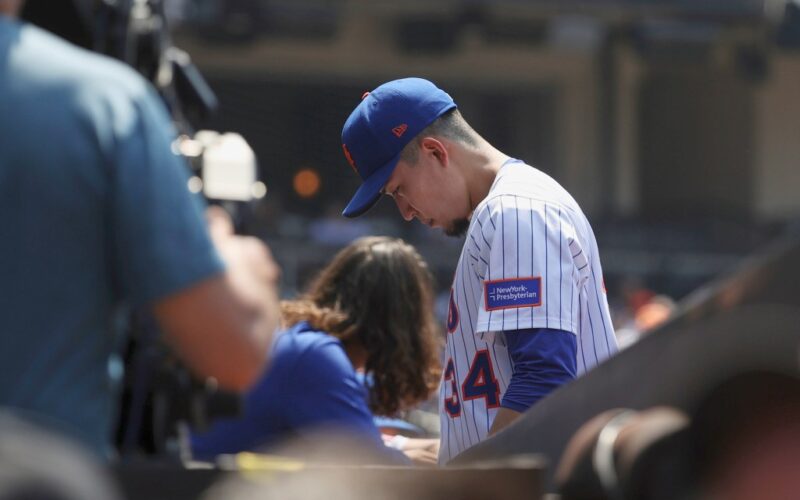Kodai Senga has been placed on the 15-day injured list and Paul Blackburn will take his next turn through the rotation. But as of Friday afternoon, the Mets had no other information on their injured ace.
The club sent Senga for an MRI on Friday afternoon, with Mets president of baseball operations David Stearns addressing the media around the same time the right-hander was being seen by doctors. The severity of the right hamstring strain that Senga suffered Thursday afternoon while running to cover first base is still not yet known, and without that information, a timeline for a return can’t be predicted.
Right-handed reliever Max Kranick was called up from Triple-A Syracuse to take his place on the roster.
“We’re just waiting on that,” Stearns said Friday at Citi Field. “I imagine with all these things, we try to run through various physicians to try to get as many opinions as possible.”
Senga, in the third year of his five-year, $75 million contract, missed nearly the entirety of the 2024 season with a shoulder injury and a calf injury. He strained his left calf in the middle of his only regular season start, leading to yet another lengthy rehab and pitch-count limits once he was made available in the postseason.
At times, it seemed as though the Mets were in the dark about Senga’s rehab progression last season. At one point, he shut himself down from a rehab assignment, despite being seemingly healthy with Senga citing the need to work on his mechanics. Getting his mechanics in the right place is important to preventing future injury, or a re-injury of a shoulder or elbow, but it became clear that some in the organization were left in the dark when it came to their star pitcher.
“A lot of players, but particularly Senga, want to be involved in the process,” Stearns said. “I think it’s important that we get on the same page as him from the jump, and that we’re all bought into what this process is going to look like. I think we got there last year.”
They got there last season late in the process. Still, better late than never. The Mets have learned from it, and don’t think it will be the same this time around.
“I certainly know Senga a lot better now than I did last year, our medical staff has now worked through a rehab progression and a rehab process with him already on multiple occasions,” Stearns said. “So I think we feel pretty comfortable that whatever this turns out to be, we’re going to be able to work very productively with him to get him back healthy.”
It was tough on the 32-year-old Japanese starter to be away from the team last year, and his goal this year was to make every start. Since he walked off the field without much of a noticeable limp Thursday, there is some hope that the strain is mild.
But for at least the next two weeks, they’ll be without Senga and his vaunted ghost fork. The club is optimistic that they can absorb his starts in the short-term with the pitching depth they already have. Blackburn, a right-hander acquired at the trade deadline last season, tossed five shutout innings against the Los Angeles Dodgers on the road in his only starts this season, then was moved to the bullpen without any room for him in the rotation.
A veteran who is not only willing to be flexible, but also an arm who has the ability to start or come out of the bullpen successfully, is a valuable piece to have.
“It definitely helps,” said manager Carlos Mendoza. “It’s important to have guys like that. We’ve been talking about our depth, and here we are again getting tested.”
Frankie Montas and Sean Manaea are also close to returning, with Montas making what is expected to be his second-to-last rehab start Friday night with Triple-A Syracuse. The two can absorb Senga’s innings if he’s out long-term. With Senga, the Mets were going to have two more starters than necessary, now it’s only one, and they can option Tylor Megill to Triple-A Syracuse to make room for one of the returning arms.
The Mets have consistently had the lowest ERA in baseball. Yes, Senga, whose 1.47 ERA is the lowest among all NL starters, has been a huge part of that. However, with the way the rest of the group has performed so far and based on their expected projections, Stearns doesn’t foresee the Mets running out of quality arms.
“It’s a good thing to have more major league quality starting pitchers than less,” Stearns said. “Frankly, I’m never really concerned about having too much [pitching] because as we saw last night — and as I’ve experienced throughout my career — it’s very, very rare where you actually get to the point where you have too many starting pitchers that you can roster. And if somehow, at some point, we get that this season, I’ll have to make some decisions, and I imagine those will be difficult decisions…
“For now, I am very happy with how the group that we’ve had to this point has pitched.”








